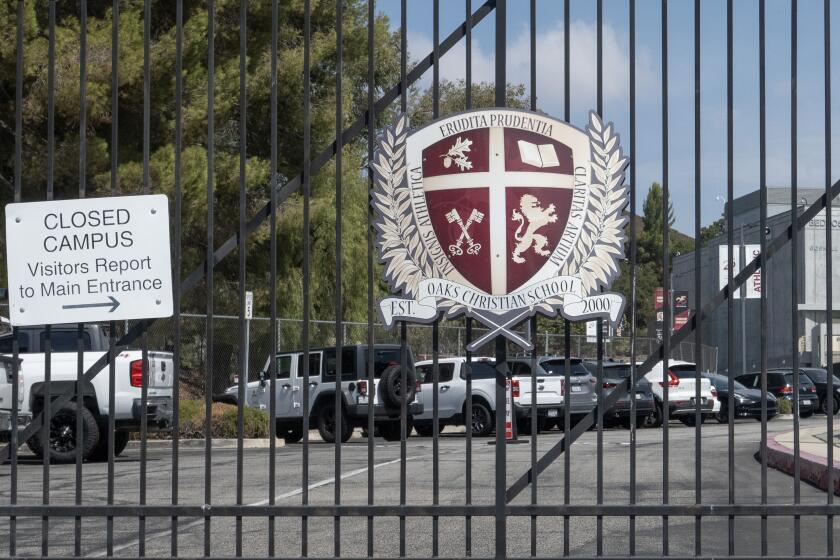When Strangers Near : Parents and Educators Struggle to Teach Children Important Safety Lessons Without Leaving the Youngsters Too Terrified to Trust Anyone
As Los Angeles Police Officer Digby Sharpe runs the Sylmar El Dorado Elementary School students through a safety drill, he asks: “Does everyone know what we say to strangers?”
The children are primed. “YES!” they shout in unison.
“What do we say to strangers?”
“NO!”
“What do you do then?”
“RUN!”
“Then what do you do?”
“TELL!”
“That’s right. Tell somebody.” Sharpe pauses. “Did everyone hear about the little girl who got taken the other day?”
Three-quarters of the kids stick up their hands.
“What happened,” Sharpe says, “was that a little girl got taken away from school. A man came up and asked if she would help him go pick up some books. And she went with him because he told her he was a teacher. He wasn’t really a teacher but she didn’t know it. And she isn’t going to be going back home. And I’ll tell you what. I don’t want that to happen to any one of you guys. So that’s why we say, ‘Always say no to strangers.’ ”
It’s a dilemma for parents and school administrators.
If adults don’t warn children about the possibility of abductions, there’s a small but definite possibility in an area as dicey as greater Los Angeles that a child could end up as Nadia Puente, 9, did--found dead in a trash can in Griffith Park.
But if grown-ups warn children about strangers, they run another risk--that of traumatizing youngsters, making them unreasonably afraid of normal, healthy social contact and otherwise trampling the flowers in what ought to be the most sunny and carefree times of their lives.
“I’m really ambivalent” about blanket warnings against strangers, says Carolyn Harris, director of the Westminster Child Center in Eagle Rock. It’s crucial for children’s healthy development to spend their first year learning to trust the world around them.
“What are we doing,” Harris asks, “if we then turn around at age 3 or 4 and say there is a whole group of people called strangers whom they can’t trust?”
Diane Swanbrow, a Toluca Lake writer, says that when her daughter started nursery school, the teachers advised her that her daughter had a suspicious streak. Now, three years later, she says, the school is telling her daughter, “never speak to a stranger.”
And that, Swanbrow says, is an impossible situation. You can’t not talk to strangers in a city like Los Angeles, where many people have no extended family or longtime friends. “Everyone is a stranger,” Swanbrow says. “If you aren’t friendly to strangers, you don’t have any friends.”
If you are standing out front watering the lawn when a stranger walks by and you smile and say hello, the first thing a child wants to know, Swanbrow says, is “Why is it OK for Mommy to talk to strangers but it’s not OK for me?”
“What are you going to say?” asks Swanbrow. “Mommy is an adult and knows a good stranger from a bad stranger? Mommy has ESP?”
Besides, Swanbrow asks, why make kids paranoid about strangers when most of the time “it’s not strangers doing it anyway--it’s friends and family members.”
No Blanket Prohibitions
It doesn’t make sense to give children a blanket prohibition against talking to strangers, agrees USC child psychiatrist Jerome Karasic. “What if (the child) is lost? You can’t say, ‘Don’t ask anyone the way home.’ ”
Los Angeles police officers who make safety presentations to schoolchildren try not to frighten them. “If we tell them a bunch of horror stories, they will leave here crying,” says Sharpe’s partner, Officer Alicia Hajewski.
But even so, some children still are frightened, by lectures at school and at home and by the graphic depictions of abductions, assaults and shootings they see on television.
Ivy Morritt, a program coordinator at the El Dorado school, says that after one lecture her son was so “petrified he wouldn’t go out for two weeks.”
Swanbrow says her daughter told her a classmate heard a lecture and got so scared he wet his pants.
Would Not Talk to Friends
Carolyn Harris says the mother of one of the students at her child care center inadvertently frightened her son so much about strangers that he wouldn’t even talk to his mother’s friends in church.
Marcy Tiffany, regional office director of the Federal Trade Commission, says she and her 7-year-old son were listening to the radio on the morning when an assailant using an AK-47 semiautomatic weapon attacked students at a Stockton school. “His face went into shock,” she says of her son. “ ‘Who shot those children,’ ” he asked. “ ‘Why did someone shoot those children?’ ”
To children, reminders of the problem are everywhere. Even the faces of missing children on milk cartons can be scary to a child, says Don Rector, supervisor of safety education for the Los Angeles Unified School District.
Because the news media focus on all the things that are wrong, rather than those that are right, parents often pick up unreasonable fears of potential dangers confronting their children.
Abductions Are Rare
Statistically, according to the Safe Kids campaign, a Washington, D.C.-based coalition sponsored in part by the National Safety Council, abductions are rare in the United States. Only 67 children were abducted by strangers in 1986. In contrast, more than 5,100 children were killed that year in automobile, swimming, falling and gun accidents.
But some parents so fear abductions, Rector says, that they will create a traffic hazard by double-parking “rather than let the kid go up to the school gate alone.”
Still, educators are quick to emphasize, just because some people are paranoid doesn’t mean a problem doesn’t exist. Nine-year-old Nadia Puente, after all, was left strangled in Griffith Park. Seven-year-old Sara Hodges was strangled last week in Santa Clarita. There have been three abductions of young girls in three East Bay communities in the San Francisco Bay Area over the last nine months.
“We live in a high-risk society,” says Ruth Rich, health educational specialist for the Los Angeles school district. “We have a lot more dangerous people on the streets than we used to--more transients, more people who should be institutionalized; there are a lot of people on probation.”
‘They Are Naive’
Children who came from countries and cultures where there isn’t such omnipresent, random viciousness and perversion are especially easy targets. “They are naive,” Rector says. “They trust everyone.”
Latchkey kids are another easy target, Rector says--the youngsters are so often needy they find it hard to resist a seemingly affectionate adult.
And finally, there is that perennial problem for a fast-moving, highly mobile society like Los Angeles--the lack of community.
“In small towns, you knew everyone’s name,” Rector notes. “You knew the dog’s name. Now, no one knows anyone. You may not even know the person next door.”
Instead, Rector notes, bustling Los Angeles is a big city where some bars open at 6 a.m. and some young girls have to endure drunks’ catcalls on the way to school.
“We are now at the point where we send a memo to the schools recommending that kids not go out trick or treating” on Halloween, he says.
Faced with this reality, parents can’t simply ignore the problem. But this doesn’t mean terrorizing children with graphic accounts of horrific disasters. Far better, Rector says, is give them firm new rules:
Never walk along isolated streets. Avoid freeway off-ramps. Take the same safe route home from school every day. Beware of tricks: “Your mother is in the hospital. She asked me to take you to her.”
Let your parents know where you are at all times. Don’t pet dogs. Don’t accept candy. Walk with a friend. Go straight home. Never get into a car with anyone not approved by your parents, and this includes, Rector says, teen-age uncles or aunts and friendly neighbors.
More to Read
Sign up for Essential California
The most important California stories and recommendations in your inbox every morning.
You may occasionally receive promotional content from the Los Angeles Times.










